Sketchup is Inacurrate???
-
N.E.A.T: never ever ask this.
-

-
@unknownuser said:
@desertraven said:
But quite on the contrary to my amazement the developers of Sketchup have not found it necessary to even attempt to make this work. (I guess they are just thinking "good enough")
dunno, i think it's best you start seeking alternatives.. i mean here in this very thead, one of the developers has said "oh.. that would be neat to have in sketchup"…
neat?


not absolutely necessary?
fighting up to this point was an uphill battle.. after john's response, that hill just turned into a vertical wall..
personally, i'm over it.. can't believe i lasted this long..
I'm quite amazed you stuck it out fighting so long and also you never seem to sleep? I'll have to look up Johns respond I may have missed it.
I'm not sure if posting here will ever do any change, but I just think spreading awareness is a good thing.I've spent so many hours working my ass off using Sketchup on various large scale projects, remembering those moments where I wished I had one of the developers at hand to just give them a good shake to get them back to the reality of what we are doing here.
But despite all frustration so far SU has served me well, if I look on the bright side.
I am able to create vast scenes with tons of buildings and still am able to work on a detail over there and not have the whole thing freeze like I would have had using 3D Max or AutoCAD.
Usually I save each building or building segment in it's own file.But anyway then again, it get's me when I see all this potential and only some glitches standing in the way of excellence. I have spent hours, and this is not just me, to hunt down a minor little issue that has suck in because either me or one of my guys hasn't payed explicit attention to what Sketchup thinks is the right way. As soon as you leave the square you are in trouble.
Many times I also experience that after opening a drawing after a day or two some minute things have changed.
I don't have a concrete example at hand, but it happened more then once and it always has to do with geometry that is on any angle that is not square. e.g. 2 or more buildings at an 12.5 degree angle to each other.One time I did an organic shaped thatched roof, every time I attempted to save the drawing Sketchup threatened to "fix" my geometry, only to add odd, twisted faces in a so far clean solid model.
I see there is lots of work to do and a long road ahead if the Dev. is serious about this product.
Anyway, I hope to see you around here some time longer, I appreciate you input and your eagerness to fight for the better of Sketchup, thanks,
Olav
-
I wouldn't want anyone to imagine that I think SU is 'good enough' either. One of the areas of contention here is down to a basic misunderstanding in terms...I think.
Take the example of Olav's quarter hemisphere. My viewpoint is why would you think that the Follow Me Tool would lathe a quarter turn under those circumstances. In order to do that, it would need to be a Rotate Tool; it isn't, it's an extrude tool...as its name suggests.
While it is true that it can be 'tricked' into being a Rotate Tool in one, very specific circumstance...lathing a profile around a full circle, it can only do that because (a) that extrude path has no beginning or end; and (b) the profile's inner edge just happens to be at the circle's centre. You have to remember, however, that it isn't actually rotating around that central axis...it's extruding along the exterior, circular path.
Like I said, this is one single, specific circumstance. It is not downscaleable to lathing a quarter or half turn...because such a path is not an infinite loop...it has ends...and at those ends Follow me will revert to its true nature as an Extrude Tool, exactly as in Olav's illustration. This is the reason that I claim such a result is neither an error nor is it illogical. It is entirely logical...for an Extrude Tool.
Why SU doesn't actually possess a proper Rotate/Lathe tool after all this time is quite another matter.

-
@alan fraser said:
I wouldn't want anyone to imagine that I think SU is 'good enough' either. One of the areas of contention here is down to a basic misunderstanding in terms...I think.
Take the example of Olav's quarter hemisphere. My viewpoint is why would you think that the Follow Me Tool would lathe a quarter turn under those circumstances. In order to do that, it would need to be a Rotate Tool; it isn't, it's an extrude tool...
Why SU doesn't actually possess a proper Rotate/Lathe tool after all this time is quite another matter.

But Alan, that is what they are selling it for or else they would of provided the revolve tool long ago.
I've watched those tutorials on SU6 when it was introduced as the architectural tool for Google Earth.
I will never forget the sentence "trust Sketchup it is smart and easy enough to know what you are doing." okay that was pertaining to the inference engine.
And that again proves their position of "it" being good enough.With the given native tools there is no alternative to creating the undesired result, and then fixing it manually.
So it still boils down to the arch and circle tool where unexpected inconsistency occurs.
as Jeff already elaborated on the "J" shows what anybody would expect of a offset tool to do when dealing with arches.
By failing to deliver a clean solution, there are pitfalls that can affect your work on the computer using SU down the road; if one does not know or pay explicit attention to the shortcomings of SU.
this example shows how inconsistent and deceptive the workflow is with SU.:
The above diagram shows how a circle is created using the inference engines suggestion.
In creating the circle I am following the red direction which creates the circle according to it's radius on a vertice (not at a half segment)
So going from there I'm going to create the half circle for my arch.Next i'm using the offset tool. Now if I know it all and am paying attention I see there is a inconsistency at both ends of the arch/ half circle. Also I notice SU breaks up the arch / half circle and inserts two end points. Why I don't know.
So let's say I want my offset half circle to be an actual half circle then what do I do??
I go in there and add two small pieces using the inference engine.Now I realize I've just gained two more end points in my geometry, I can not get rid of, unless I explode the curve.
If i was to close the shape of my two arches I would be able to extrude my 3d arch but then would see that I need to smooth the two lines appearing where the extra endpoints are.
At this point I would rather draw a brand new arch.
Anyway In case I say who cares it's only SU, good enough, I'll take the thing as it comes.
So the above diagram shows the whole dilemma, either the post will not be consistent with the width of the arch, not being 2' but 1' 11 13/16" and that added up in an array can cause trouble just like that,
or I fix it manually, gaining the before mentioned extra endpoints.So the extra endpoints can lead to a problem in SU, that is if you don't pay explicit attention, it will be a pit fall.
The inference engine could, because it is so close to the desired endpoint, pick the wrong one and then your faces won't close on some wall down the road when you're not thinking of the extra endpoint any more.
This is one of those minute little things that can get you down the road. And then you got to get back and find that little bugger.I think the circle and arches really need to follow what one expects them to do when offsetting, copying, or extruding along them as a path. They are circles and arches and should not act as if they were segments.
-
@alan fraser said:
Why SU doesn't actually possess a proper Rotate/Lathe tool after all this time is quite another matter.

that reminded me of something from when sketchup8 first came out.. they used this picture as promo for the new solid tools..
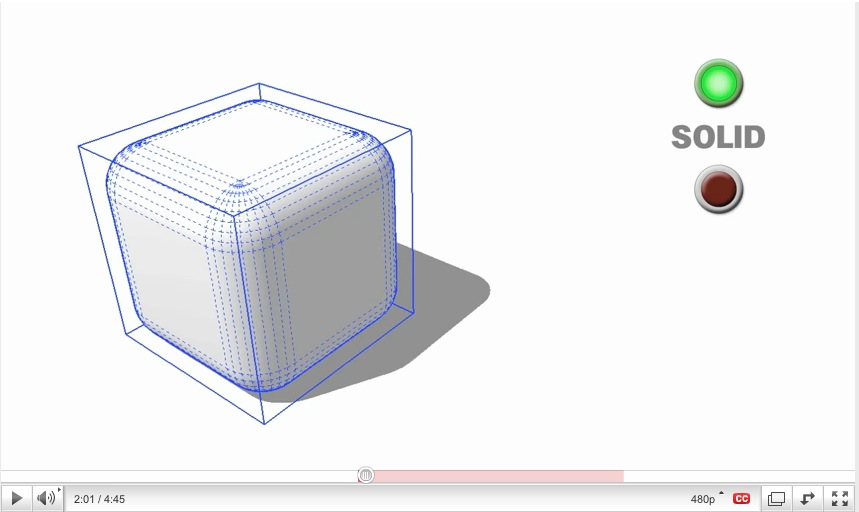
but you can't draw that with sketchup tools and have it be recognized as solid.. try that with followme and you'll have all sorts of problems

http://sketchucation.com/forums/viewtopic.php?p=268160#p268160
-
Olav, in the case of the arches, wouldn't it make more sense not to bisect the circle until after you have offset it? And when you offset it, just ignore the value in the Measurement box, but offset by inferencing across the top of the established pillar?
That way, you not only avoid all the nonsense of having to deal with little line stubs, but you also get an entirely consistent vertex to vertex distance up the pillar and right around the arch.
Or am I missing something?
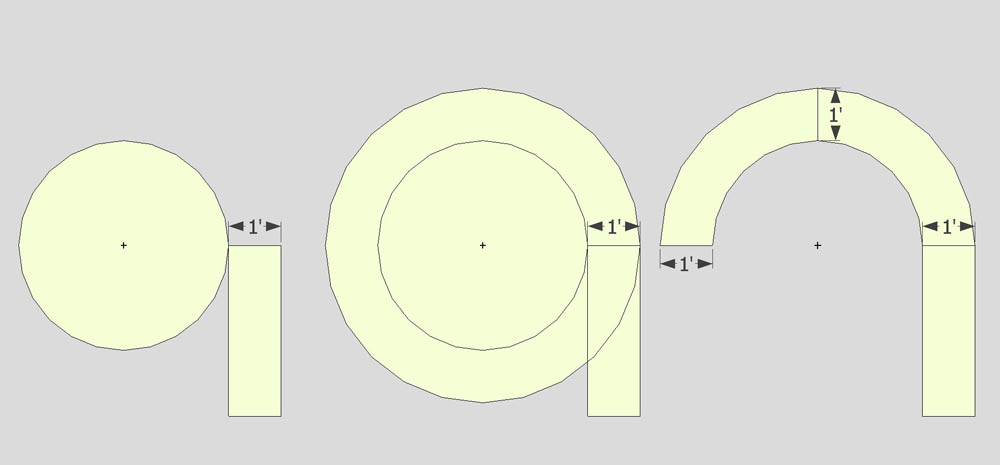
-
@unknownuser said:
Anyway In case I say who cares it's only SU, good enough...
...as any polygons / box / modelers

But it's one of the more friendly!
-
Now this is the best screw up I've encountered so far with the follow me tool,
Un-frigging believable! look at the original arch on the bottom, the outer one!
I used the inner arch as the path

-
Why not put an image or a V6 version ?
-
-
@alan fraser said:
Olav, in the case of the arches, wouldn't it make more sense not to bisect the circle until after you have offset it? And when you offset it, just ignore the value in the Measurement box, but offset by inferencing across the top of the established pillar?
That way, you not only avoid all the nonsense of having to deal with little line stubs, but you also get an entirely consistent vertex to vertex distance up the pillar and right around the arch.
Or am I missing something?Yes, Alan, knowing SU that, would be the better way.
But the best would be if SU did handle this correctly.
Otherwise I can't work intuitively and the way I like to and I will be forced to work the way SU dictates me to.Edit: Also, the next guy I hire to do some work for me may not know of this and assume he'll just draw a shape and quickly outline it, knowing little about what is lurking beneath the obvious - layer.
Then I have to when all is done make sure this was all done right to avoid a pit fall down the road?
-
@alan fraser said:
it isn't, it's an extrude tool...as its name suggests.
and at those ends Follow me will revert to its true nature as an Extrude Tool, exactly as in Olav's illustration. This is the reason that I claim such a result is neither an error nor is it illogical. It is entirely logical...for an Extrude Tool.
getting into what may be a semantics issue now but regarding what an extrude tool means..
if follow me were an extrude tool, it should give this as the result in olav's scenario..
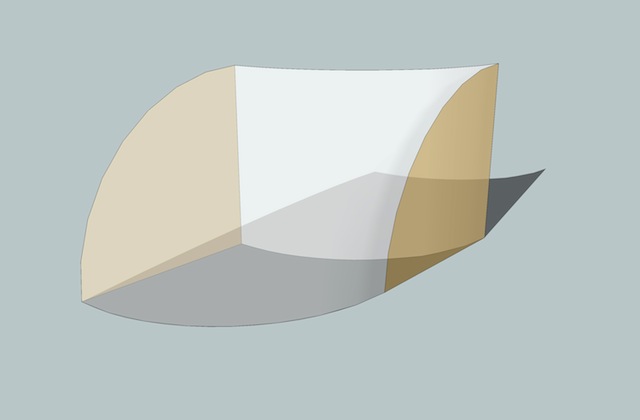
follow me is a sweep tool.. a 1 rail sweep tool.. and it should be able to draw an 1/8th sphere given olav's setup curves..
.
-
@driven said:
Create a new tool by exposing, existing, functionality of arcs and circles and cardinal points.
re: new tool.. not so much relating to the main topic of this thread.. there's a ruby that's probably not incredibly tough to write which would be pretty cool..
as i see it: (meaning.. hey, i haven't super thought this through so pick it apart
 )
)it's a circular guide tool (spoken about often but it seems rubiable)
• basically looks and acts just like the circle tool *
• upon setting radius , all intersecting geometry on that plane gets marked with a cpoint **
• if i hold option, i can draw another circle guide and have the intersections between the two be marked with a cpoint**that's basically it (for starters
 )
)- ie- click a centerpoint, then the circle guide visually expand/contracts upon moving the mouse.. click somewhere to set radius.. or use the measurement box
** the cpoints should be grouped.. makes it easier to delete them later or hide etc..
*** possibly at this point (working with multiple guides) it should no longer give intersections for existing geometry.. they're only interacting between themselves..
[edit]
fwiw-- it should look and act pretty much like vertex tools' circle select tool.. (except it snaps)
(maybe make it a different color or something so it doesn't look like a straight rip-off .. or a group effort.. someone does the
.. or a group effort.. someone does the  math and tt does the
math and tt does the  )
)[edit2] -- re: edit#1.. damn.. it would also have to be able to lock to planes and such like the circle tool (or better yet, the protractor..) but it has to look like vertex tools ... and in one fell swoop, smthg that started simple enough,...

- ie- click a centerpoint, then the circle guide visually expand/contracts upon moving the mouse.. click somewhere to set radius.. or use the measurement box
-
Sorry Jeff, it's not me indulging in semantics ...it's you. The Follow Me Tool is most definitely an extrude tool, not a rotate tool. I've already pointed out the single instance in which it can be used as a form of rotate tool...a complete 360 degree lathe....and page after page of this thread has been devoted to various people zeroing in on that one specific aspect and complaining about the fact that you can't downsize it to a 180 or 90 degree turn. You can't...it's 360 or nothing.
You know as well as I do that any extrude tool worthy of the name can extrude along a path, not just the contrived example you posted...which is more akin to Vector P/P...but along a curved path, not a single vector. It is, in fact, a loft operation. Did you construct it manually, or did you simply use Loft along Path?
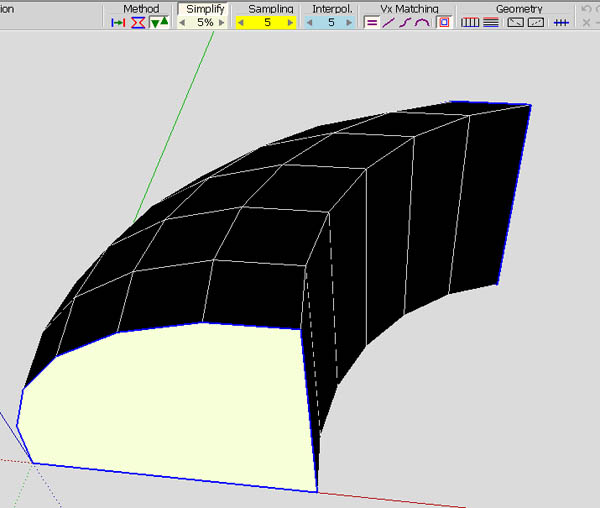
Follow Me has an infinity of uses beyond its very narrow use covered in these ages. You can't possibly claim it's any kind of revolve tool when it's used to extrude a profile along paths like these hydraulic pipes. Of course it's an extrude tool...but your definition of what an extrude tool ought to do would have it maintaining the orientation of the original circle as it follows the path around those bends. That would produce a totally ludicrous result.
Any kind of Rotate Tool would require you to define the axis of rotation and then specify the degree of rotation about that axis...producing exactly what Olav would like to see; and exactly what you have to do when 'programming' a dynamic door component, for example. We don't have that...because we don't have a Rotate Tool. -
@alan fraser said:
Sorry Jeff, it's not me indulging in semantics ...it's you. The Follow Me Tool is most definitely an extrude tool, not a rotate tool.
it's neither..it's a sweep tool..
i dunno.. i'm just comparing to what i see in other apps which have all three tools.. extrude, sweep, and revolve.. (maya, autocad, rhino, cheetah, probably max, solidworks, etc..)and follow me matches sweep.
extrude does what i showed above..
revolve does what it sounds like it would dopush/pull is an extrude tool.. a simple one.
[edit] as in.. i'm definitely not claiming to be some sort of voice of authority on the definition of modeling tools.. i'm just saying what i see in other places.. but if you go to another app and try to extrude a profile along a path expecting a followme type deal, you're probably not going to like the results.. you'd want to do a sweep instead..
-
I'd say, some plugin developer has lots of meat for a at least a couple of commercial plugins here.
(Don't look at me - I've got too many projects already.)
-
@thomthom said:
I'd say, some plugin developer has lots of meat for a at least a couple of commercial plugins here......
Imo it would be a waste of time and effort to create an offset tool for segmented true arcs unless when dealing with tangent connections. Otherwise you'll be asking for 1+1=3 at connections arc<>connecting geometry. For 'there's no way you can keep an equal number of full segments in both the original arc and its offset. Only with true arcs where both have an infinite number of segments.
If however you use a segmented arc with true offset in a "not tangent connection to other geometry" situation, you'll be left with three choices:- you'll have to accept cut off and/or extended segments in the new offset (segmented true arc) at either end. Then what in a next offset step? For you only have a segmented true arc with less whole segments covering a smaller angle. The ends are no longer of use. In between, the corresponding vertices distances will be equal to the offset. (this option might have a chance)
- Full equal segments? You'll be forced to redraw the arc from intersections of both miter lines and the true offset as if it were NOT a segmented arc. So then you’ll have an arc with equal number of segments but completely useless. Its midpoint appears to be not coinciding. Its vertices are not on the radii running to the vertices of the original arc. They just do not lign up.
- The new offset (segmented true arc) can't be properly connented to the rest of the offset when you do want both arcs to cover the same angle.
Maybe that’s why the developers didn’t and don’t want to burn their fingers on this issue. The more covenient way is how segmented arcs are dealt with now.
Not until we have true (I mean true) arcs, this whole problem will be over.If its about just only offsetting the segmented arc as if it were a true arc, that is quite easy with SU's native tools. And I understand there's already TIG's plugin to do so. Integrating the result in the rest of the geometry? .... See above 1) to 3).
-
As you already know that FollowMe treats all paths as a set of co-vertexed edges, ignoring any 'arc-ness', then it's a little ingenuous to illustrate it doing just that as if it's a surprise.
Your original arc is not a 90 degree swept quarter circle. If you rotate-copy it at 90 degrees x3 about the center-point they'll overlap.
The initial face orientation must be guessed but I suspect it wasn't perpendicular and thereby hangs the distortion.
If you want a true 'lathed' result of sweeping a face around an axis by say 90 degrees then there are plenty of tools to do this. FollwMe just isn't one of them. "When the only tool you have is a hammer everything starts to look like a nail..." Get a screwdriver when you need it!
The illustrated version made using my ExtrudeEdgesByLathe works fine.
It also shows the discrepancy between a true sweep and your inner arc...
If you want a form that actually uses that 'off' inner arc then other tools, like CurviLoft or my own EEbyRails tools will do this relatively simply too...
-
Lathed hemisphere using Follow Me. I rest my case. SU thinks it's an extrusion; the developers seem to think it's an extrusion.
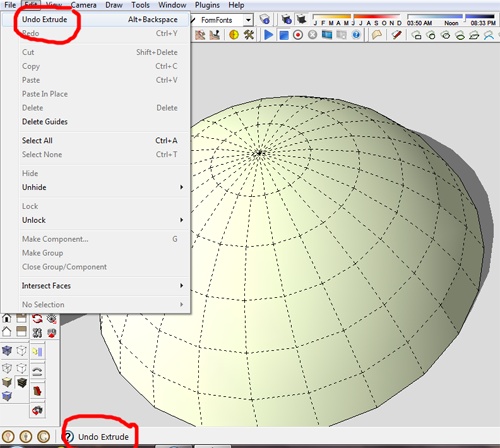
I absolutely agree. Thom...especially an intuitive Revolve/Lathe tool that works pretty much like Follow Me; and an Offset tool that accurately offsets vertices on a curve, but edge perpendiculars on everything else.
Having said that, we already have tools that do at least some of what is being asked for. This is Olav's last example...but done using Curviloft, not Follow Me. Seen from underneath, all those radii (including the end ones) are exactly the same length.
{Edit} I see TIG beat me to some of this.
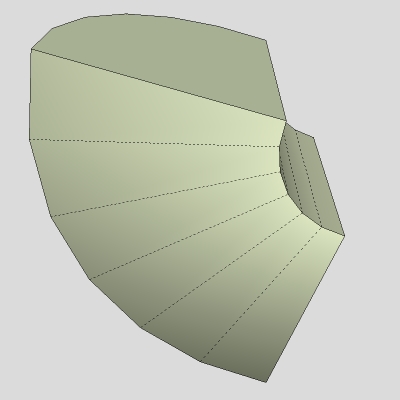
Advertisement










